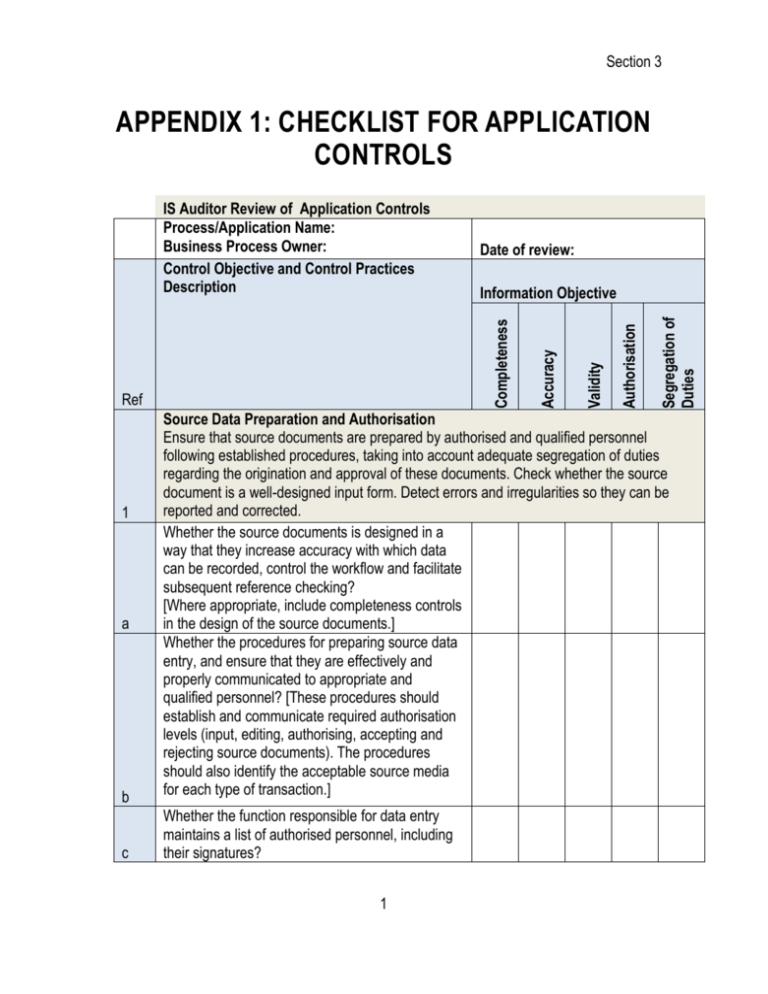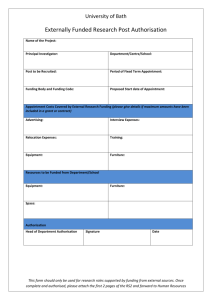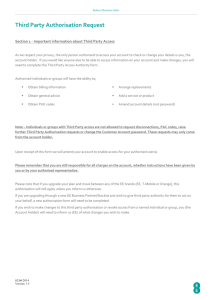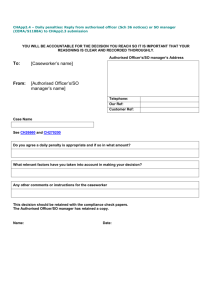Appendix 1: Checklist for Application Controls
advertisement

Section 3 APPENDIX 1: CHECKLIST FOR APPLICATION CONTROLS Date of review: Segregation of Duties Authorisation Validity Ref Accuracy Information Objective Completeness IS Auditor Review of Application Controls Process/Application Name: Business Process Owner: Control Objective and Control Practices Description b Source Data Preparation and Authorisation Ensure that source documents are prepared by authorised and qualified personnel following established procedures, taking into account adequate segregation of duties regarding the origination and approval of these documents. Check whether the source document is a well-designed input form. Detect errors and irregularities so they can be reported and corrected. Whether the source documents is designed in a way that they increase accuracy with which data can be recorded, control the workflow and facilitate subsequent reference checking? [Where appropriate, include completeness controls in the design of the source documents.] Whether the procedures for preparing source data entry, and ensure that they are effectively and properly communicated to appropriate and qualified personnel? [These procedures should establish and communicate required authorisation levels (input, editing, authorising, accepting and rejecting source documents). The procedures should also identify the acceptable source media for each type of transaction.] c Whether the function responsible for data entry maintains a list of authorised personnel, including their signatures? 1 a 1 Module 6 d e f 2 a b Whether all source documents include standard components and contain proper documentation (e.g., timeliness, predetermined input codes, default values) and are authorised by management? Whether application automatically assigns a unique and sequential identifier (e.g., index, date and time) to every transaction? Whether the document that are not properly authorised or are incomplete to the submitting originators for correction, and log the fact that they have been returned is maintained?Whether review of logs periodically done to verify that corrected documents are returned by originators in a timely fashion, and to enable pattern analysis and root cause review? Source Data Preparation and Authorisation Establish that data input is performed in a timely manner by authorised and qualified staff. Correction and resubmission of data that were erroneously input should be performed without compromising original transaction authorisation levels. Where appropriate for reconstruction, retain original source documents for the appropriate amount of time. Whether criteria for timeliness, completeness and accuracy of source documents have been communicated? Whether mechanisms are there to ensure that data input is performed in accordance with the timeliness, accuracy and completeness criteria? Whether pre-numbered source documents for critical transactions are used? Whether application allows identification and listing of missing source documents? Whether definition for who can input, edit, authorise, accept and reject transactions, and override errors is there? Whether the same is as per roles and responsibilities of individual and record supporting evidence to establish accountability is maintained? c 2 Section 3 d e f g 3 a Whether procedures to correct errors, override errors and handle out-of-balance conditions, as well as to follow up, correct, approve and resubmit source documents and transactions in timely manner are defined? Whether application system generates error messages in a timely manner and as close to the point of origin as possible? Whether the transactions are processed without errors being corrected or appropriately overridden or bypassed? Whether the errors that cannot be corrected immediately logged in an automated suspense log? Whether error logs are reviewed and acted upon within a specified and reasonable period of time? Whether errors and out-of-balance reports are reviewed by appropriate personnel, followed up and corrected within a reasonable period of time, and that, where necessary, incidents are raised for more senior attention? Whether automated monitoring tools are used to identify, monitor and manage errors? Whether all source documents are safe stored (either by the business or by IT) for a sufficient period of time in line with legal, regulatory or business requirements? Accuracy, Completeness and Authenticity ChecksEstablish that data input is performed in a timely manner by authorised and qualified staff. Correction and resubmission of data that were erroneously input should be performed without compromising original transaction authorisation levels. Where appropriate for reconstruction, retain original source documents for the appropriate amount of time. Whether the transaction data are verified as close to the data entry point as possible and interactively during online sessions? Whether the transaction data, whether peoplegenerated, system generated or interfaced inputs, are subject to a variety of controls to check for accuracy, completeness and validity? 3 Module 6 b c d e f 4 a b Whether controls to ensure accuracy, completeness, validity and compliancy to regulatory requirements of data input put in place? Whether validation criteria and parameters should be subject to periodic reviews and conformation? Whether access control and role and responsibility mechanisms are established so that only authorised persons input, modify and authorise data? Whether requirements for segregation of duties for entry, modification and authorisation of transaction data as well as for validation rules defined? Whether report of transactions failing validation generated? Whether report all errors are generated in a timely fashion? Whether transactions failing edit and validation routines are subject to appropriate follow-up until errors are remediated? Whether information on processing failures is maintained to allow for root cause analysis and help adjust procedures and automated controls? Processing Integrity and Validity Maintain the integrity and validity of data throughout the processing cycle. Detection of erroneous transactions does not disrupt the processing of valid transactions. Whether mechanisms to authorise the initiation of transaction processing and to enforce that only appropriate and authorised applications and tools are used defined and put in place? Whether processing is completed and accurately performed with automated controls? [For example: Controls may include checking for sequence and duplication errors, transaction/record counts, referential integrity checks, control and hash totals, range checks, and buffer overflow.] 4 Section 3 c d e f g h Whether transactions failing validation routines are reported and posted to a suspense file? Whether the errors are reported in timely fashion? Whether the information on processing failures is kept to allow for root cause analysis and help adjust procedures and automated controls, to ensure early detection or to prevent errors? Whether the transactions failing validation routines are subject to appropriate follow-up until errors are remediated or the transaction is cancelled? Whether there is a unique and sequential identifier to every transaction (e.g., index, date and time)? Whether an audit trail of transactions processed. Include date and time of input and user identification for each online or batch transaction maintained? Whether there is a listing of sensitive transactions and before and after images maintained, to check for accuracy and authorisation of changes made? Whether integrity of data during unexpected interruptions in data processing with system and database utilities, maintained? Whether controls are in place to confirm data integrity after processing failures or after use of system or database utilities to resolve operational problems? Whether any adjustments, overrides and highvalue transactions are reviewed promptly in detail for appropriateness by a supervisor who does not perform data entry? i Whether reconciliation of file totals done? [For example, a parallel control file that records transaction counts or monetary value as data should be processed and then compared to master file data once transactions are posted. Identify report and act upon out-of-balance conditions.] 5 Output Review, Reconciliation and Error Handling Establish procedures and associated responsibilities to ensure that output is handled in an authorised manner, delivered to the appropriate recipient, and protected during 5 Module 6 transmission; that verification, detection and correction of the accuracy of output occurs; and that information provided in the output is used. a b c d Whether the handling and retaining output from IT applications, follow defined procedures and consider privacy and security requirements? Whether procedures for communicating and followup defined for distribution of output? Whether physical inventory of all sensitive output, such as negotiable instruments taken and compared it with inventory records? Whether there are procedures with audit trails to account for all exceptions and rejections of sensitive output documents? Whether out-of-balance control totals exist and exceptions reported to the appropriate level of management? Whether procedure exists to check completeness and accuracy of processing before other operations are performed? Whether reuse of electronic output subject to validation check before re-use? Whether procedures are defined to ensure that the business owners review the final output for reasonableness, accuracy and completeness? Whether the output is handled in line with the applicable confidentiality classification? Whether the potential errors are logged in a timely manner? e f Whether for sensitive output, definition exists as to who can receive it? Whether such output is properly labelled for reorganisation? 6







